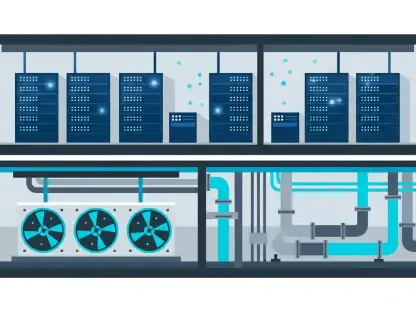The digital landscape in 2025 has been profoundly impacted by a series of widespread Internet disruptions that have tested the resilience of global communication networks. Throughout the second quarter, the Internet faced unprecedented challenges from various sources, including government-imposed shutdowns, deliberate cyberattacks, power infrastructure failures, and unexpected technical issues. These events have collectively shaped a period now referred to as the “shutdown season,” revealing the vulnerabilities of our interconnected world. This article delves into these challenges, exploring the key themes that have emerged and examining their broader implications for industries heavily reliant on Internet stability.
Government-Directed Internet Shutdowns
Political Motives Behind Shutdowns
Government-directed Internet shutdowns have become a prominent tool used by nations to exert control during periods of political unrest. In particular, countries such as Libya, Iran, Iraq, Syria, and Panama initiated blackouts to maintain order in the face of looming threats to their governments’ stability. These shutdowns highlight a calculated move to prevent dissent and maintain regime stability, often under the guise of preserving national security. The strategic use of these shutoffs underscores the fragile balance between digital freedom and political governance, as authorities grapple with the challenge of maintaining control in an age where information flows freely across borders. In many cases, Internet shutdowns have been deployed as a defensive strategy to prevent external influence, as seen in Iran following Israeli attacks on nuclear sites. The efficacy of such measures remains a subject of debate, raising important questions about their broader impact on communication and access to information.
Examination-Based Blackouts
Another dimension of government-directed shutdowns arises from the need to secure examination periods from academic misconduct. Both Iraq and Syria implemented Internet restrictions during exams, albeit using different approaches to minimize disruptions to daily life. In Iraq, extensive limitations affected a wide array of networks, reflecting a stringent approach to maintaining integrity. In contrast, Syria opted for cellular-only blackouts, demonstrating a more refined method that aimed to balance disruption with the need to preserve essential connectivity. These examination-based shutdowns illustrate the complex interplay between academic standards and technological accessibility, prompting a reevaluation of traditional methods used to ensure fair examination conditions in the digital age.
Cybersecurity and Infrastructure Vulnerabilities
Cyber Threats Influence Shutdowns
The escalating threat of cyber warfare has profoundly influenced Internet disruptions, with countries adapting their networks to mitigate external threats. Iran, for example, responded to Israeli cyberattacks with extensive Internet shutdowns aimed at protecting sensitive sites and data. The strategic implementation of such shutdowns highlights the integral role of cybersecurity in national defense plans, as governments grapple with the necessity to safeguard their digital assets from hostile actors. This defensive posture, however, raises critical questions about the broader implications on everyday users and businesses who rely on consistent Internet service for continued operations. These developments emphasize the growing intersection between cybersecurity measures and digital communication, urgently calling for strategies that adequately protect while maintaining open access.
Technical Failures and Network Fragility
In North America, technical failures caused considerable Internet disruptions, underscoring the inherent fragility of networking infrastructure. Major providers like Bell Canada and Lumen/CenturyLink faced service interruptions due to errors in router updates and DNS-related complications, resulting in widespread outages that affected users across regions. These incidents emphasize the importance of robust infrastructure management and contingency planning, particularly for service providers tasked with maintaining seamless connectivity. As reliance on complex technological frameworks grows, the potential for technical mishaps that disrupt communication underscores the need for proactive measures aimed at minimizing impact and ensuring rapid recovery during unforeseen events.
The Interconnection between Power and Digital Networks
Implications of Power Failures on Connectivity
The interconnected nature of power and digital networks has been starkly illustrated by power infrastructure failures, which have led to cascading impacts on Internet services. Notably, the Portugal-Spain outage resulted in significant disruptions across the Iberian Peninsula, affecting international connectivity due to the interdependencies between electrical and digital frameworks. This situation reveals a critical vulnerability within the infrastructure that connects vast regions, highlighting a pressing need for comprehensive planning that incorporates redundancies and failsafe mechanisms. Consequently, the resilience of communication networks is contingent on parallel advancements in power infrastructure, necessitating integrated strategies that address both domains to ensure uninterrupted access in the face of such failures.
The Role of Infrastructure Planning
The importance of infrastructure planning becomes evident in the wake of widespread Internet disruptions, as dual dependencies demand coordinated responses to restore connectivity quickly. Ensuring robust infrastructure requires anticipating potential points of failure and implementing frameworks that support rapid recovery. By understanding the systemic risks posed by intertwined digital and power networks, stakeholders can develop strategies aimed at reinforcing weak links and minimizing disruptions. Crucially, this approach involves integrating diverse sectors and technologies to establish fallback systems, equipping networks with the tools needed to adapt effectively to unforeseen challenges and maintain uninterrupted communication channels.
Strategic Implications for Digital Marketing
Geographic Diversification and Risk Mitigation
The persistent threat of Internet disruptions poses a considerable challenge to digital marketing efforts, highlighting the need for strategic diversification to mitigate risks associated with localized outages. For businesses reliant on programmatic advertising and real-time bidding systems, dependence on stable connectivity carries significant implications for campaign efficacy. Geographic diversification emerges as a key strategy, enabling marketers to circumvent disruptions by distributing operations and expanding into areas less affected by shutdowns. This approach not only ensures continued access to target audiences but also enhances resilience against potential regional impacts, providing a pathway for sustained engagement amid variable connectivity conditions.
Adaptation to Technological Dependencies
Understanding technological dependencies is critical for marketers seeking to bolster campaign effectiveness against the backdrop of Internet disruptions. The role of DNS resolvers and similar technologies is pivotal, particularly when outages can compromise real-time data exchanges. In response, marketers must develop adaptive strategies that account for potential technological failures, implementing alternative workflows and secondary solutions that ensure continuity. In addition, fostering collaboration with technology providers to anticipate and address vulnerabilities may offer additional safeguards, equipping digital marketing operations with the tools needed to navigate disruptions while maintaining campaign objectives.
Moving Forward Amid Uncertainty
Resilient Strategies and Forecasting
The events of the second quarter of 2025 underscore the urgent need for resilience strategies that encompass governmental, infrastructural, and business domains. By forecasting potential disruptions and adopting integrated approaches that address diverse risks, stakeholders can build communication networks capable of enduring unexpected challenges. Such efforts require an appreciation of interdependencies and a commitment to establishing frameworks that support continuity while actively engaging with evolving technological trends. Resilience strategies must be flexible, incorporating innovations that adapt to emerging threats while ensuring the integrity of operations and services reliant on Internet stability.
The Future of Digital Connectivity
In 2025, the digital landscape has been dramatically altered due to a series of sweeping Internet disruptions that have challenged the resilience of global communication networks. The disruptions that arose in the second quarter of this year resulted from a multitude of sources, such as government-enforced shutdowns, targeted cyberattacks, failures in power infrastructure, and unforeseen technical glitches. This collective barrage of issues has led to what is now known as the “shutdown season,” highlighting the vulnerabilities inherent in our interconnected digital world.
This scenario underscores a crucial theme: the fragility of the systems we heavily depend on. Industries that rely extensively on a stable Internet, such as finance, healthcare, and e-commerce, have been forced to reconsider their strategies and invest more heavily in contingency planning. The upheaval serves as a harsh reminder of our dependency on digital platforms and underscores the importance of developing more robust, adaptable networks to withstand such disruptions.
The “shutdown season” not only serves as a wake-up call but also as an impetus for change. The experience has revealed a pressing need for industries and governments alike to bolster their cyber defenses, improve infrastructure resilience, and collaborate on international standards that prioritize continuity and security. As these events continue to shape our world, they lay the groundwork for a resilient future in which adaptability and innovation are pivotal.









